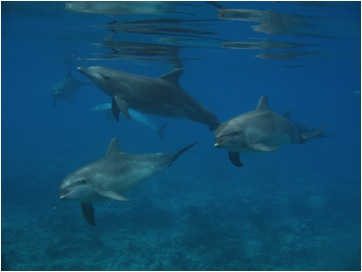Febuary 2013 Expedition - Frequent encounters with dolphins, sharks and manta rays
Chagos is both an important and amazing location for coral reef research.
This is my second trip to Chagos, the first being in 2010, when I helped Dr Nicholas Graham measure the size and abundance of reef fishes, to derive an estimate of the total biomass or weight of reef fishes at each of the atolls. What we found was that the biomass of fishes in Chagos, and especially at the outer atolls, was higher than anywhere else in the Indian Ocean.
The most striking thing about diving in Chagos is the large size of the coral trout (Plectropomus spp.), which could probably eat most of the coral trout I am used to seeing on Australia’s Great Barrier Reef. This is hardly surprising given the limited fishing in Chagos, but is strong testament to the importance of having large marine protected areas that are completely closed to fishing.

Photo: Dolphins swimming in Chagos (c) Morgan Pratchett
Aside from protection from fishing, the isolation of Chagos from virtually all direct anthropogenic disturbances, provides an important setting for studying the ecology and function of coral reef ecosystems. Many of the scientists that have visited Chagos, including myself, have done so for the express purpose of studying the status of coral reef organisms or ecological processes in the absence of any harvesting, extraction, pollution, or eutrophication. This provides a benchmark for understanding what is at risk or already lost, as reefs are becoming more degraded around the world. This also helps identify critical elements of these complex ecosystems that require specific management attention.
The main purpose for this trip is to document the biodiversity of cryptic invertebrates, such as small crabs and shrimps, which is a part of the PhD research being undertaken by Ms Catherine Head from the University of Oxford.
As such, we are deploying Autonomous Reef Monitoring Structures (ARMS), which are standardised habitat units developed by NOAA, as way to measure biogeographical patterns of diversity among cryptic invertebrates.
These ARMS have been deployed throughout many locations in the tropical Pacific and the project is now being expanded to include the Indian Ocean. Chagos is a key location for this research both because of its geographical position in the central Indian Ocean and the relatively pristine condition of the reef environments. The results of this work will not become apparent until we retrieve the ARMS in one year, but we expect to find much higher levels of biodiversity than has been recorded at more degraded locations around the tropical rim of the Indian ocean.
During this trip, I am also measuring rates of coral growth for the dominant branching corals, Acropora and Pocillopora.
These corals are very important in providing habitat for many different coral reef fishes, but are also considered to be extremely vulnerable to climate change. Importantly, Acropora and Pocillopora coral are the first to bleach and die following extended periods of unusually hot weather.
Moreover, gradual increases in ocean temperatures and emerging effects of ocean acidification could be compromising the growth rates of these corals. If so, this will reduce the capacity of normally fast-growing corals to recover from periodic disturbances, such as bleaching episodes.
To measure coral growth, I am staining the skeletons of individually tagged colonies, which then need to be retrieved in 1 year to measure how much new skeleton has been added since they were stained. The growth rates of these coral will then be compared to other reef locations around the world, as well as serving as a baseline for subsequent studies within Chagos to assess whether climate change is impacting on coral growth.
Whilst undertaking this research we are regularly confronted by spectacular ocean vistas with very high coral cover, huge schools of large fishes, and frequent encounters with dolphins, sharks and manta rays. I am extremely grateful for the opportunity to work in Chagos, and for this I must thank Professor Charles Sheppard, Professor John Turner and all the sponsors for recent and upcoming expeditions including the Darwin Initiative, Zoological Society of London (ZSL), and the Chagos Conservation Trust (CCT).
Professor Morgan Pratchett
Creole Translation:
Chagos ene ziles ki vraiment jolie et ousi ene lendroit ideal pou vine etidier corail . sa fair 2eme fois ki mo vine dans chagos , mo premier expedition ti en 2010 kand mo ti vine aide doctor Nicholas Graham mesire grander eek abundance poisson lor bane ziles chagos pou coner ki kantiter poisson ena environ lor sak ziles . ceki nou ine remarker , cest ki ena plis poisson dans chagos ki nimporte kot sa dans locean indien . Plonger dans chagos extra ordinaire par nombre ek larger corail ki nou fine trouver . moone abitier etidier corail dans l’australie mais mo penser ki chagos ena pli boucoup corail ki nimporte kot sa . en place couma chagos nou bizin proteger contre la peche meme si so la mer rempli ek poisson en abondance .
Apart protect li contre la peche , chagos li ene ziles kot pena derangement et pour sa lie ne place ideal pou etidier function so la mere ek fer bane reserche . tout bane scientist kine vine la oci moi meme ine trouver ki l’absence pollution , exploitation zot ine capave fer zot bane reserche ek decouvert bane specimene ki zot ti p roder . sa pou permete zot comprand bane risk ki pe arriver ou kine fine arriver couma bane corail pe disparaitre .

